Each owner of their own homes is committed to make its design unique and unrepeatable. One of the most flexible means to realize this is a tile. This finishing material not only has high strength, but also has a pleasing appearance. A lot of textural patterns and colors makes it possible to apply a variety of options for tiling, thus translating into reality their dreams come true.
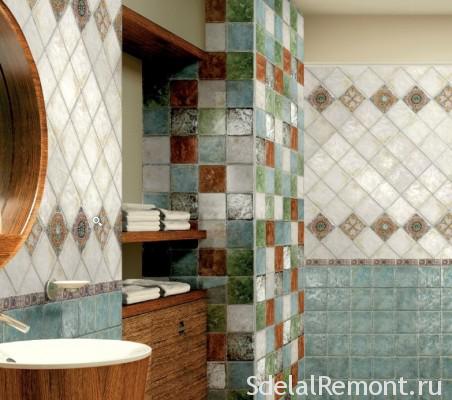
Today, the sale is a huge variety of tiles, both in form, and for coloring. Many companies even offer printing services of any image on it with a high-strength coated Glazed composition to impart firmness and bright color. Mosaic tiles on the floor or wall will perform an exclusive design and beautifully decorate any room shape.
Choosing tiles type depending on the destination
Large tile has a regular geometric shape, that talks about the possibility of finishing the premises only with ideal settings. The walls are straight and exactly perpendicular to the ceiling to the floor. To finish curved walls is better to use a mosaic of finely textured tiles. Small geometric dimensions of each fragment perfectly conceal unevenness of the walls and other surfaces, creating a visual effect ideal geometry.
Tiles can be laid as a monochrome and two-color, and colorful. Today, the sale is a huge variety of its. Dark colors visually narrow space, so it is better to decorate some pieces on a light background. The contrast of light and dark always created an incredible impression on others. If you need to clearly distinguish between the floor and wall, it is better to put one-color tiles on the elements, as if sharing their, and stand out from the background.
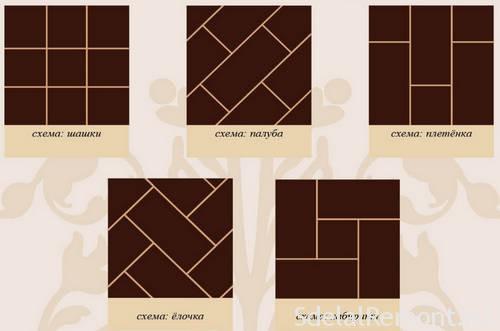
But in addition to shade an important component of design are ways of tiling. They are also there are several varieties, depending on its form. We give laying types from the simple to the complex:
- base;
- vperevyazku;
- diagonally;
- modular;
- alternating shades.
basic way
One of the easiest and cheapest tiling scheme is a basic. It provides for an arrangement of all elements in the weld seam, thereby highlighting the horizontal and vertical lines. The advantages of this type provides a small amount of waste and ease of performance. For a perfectly flat geometry cause enough markup, install beacons and attach the cord.
Laying process does not change over the entire area. The basic method narrows the space, visually highlighting the boundaries between the elements of the room.
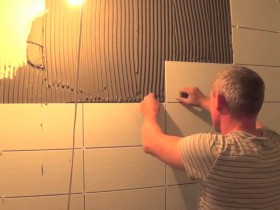
Ideal for laying tiles in this manner is sufficient to align the walls and install beacons on the perimeter. Strict adherence to the geometric parameters and the constant control of the position of each tile and area level, undoubtedly, give an amazing result.
In perevyazku
Type tile in ligation is the same base, Only with an offset number for each subsequent ½ of the length of each fragment. such a method, It is relatively simple, perfectly hide the nuances of the finishing material, as well as some uneven walls. You can also use a variant with offset stacking and 1/3 and ¼. Thereby obtaining a dynamic effect of moving rows. To implement this method requires use square tiles.
The combination of two or more colors
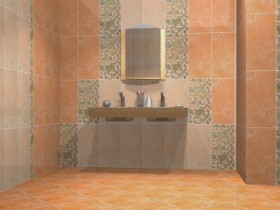
The tiles can be laid on the walls and floor, alternating between two or more colors. In this case both of the above options are ideal for the realization of the planned. The contrast of black and white will create a visual similarity chessboard. This variant is very common today and is popular. The alternation of colors can be used in the following ways, creating a unique and unique bathroom design.
diagonal method
This method of laying the tiles is the most time consuming and costly technologically. This is due to the fact, the horizontal and vertical lines connecting the tiles are placed on the floor and the ceiling is not perpendicular, Like basic, and with an oblique angle 450. This type of visually expands the space due to the multi-directional profile lines. It is actively used there, where space is limited and needs to be visually expand. But it is also important to take into account the color of the fabric.
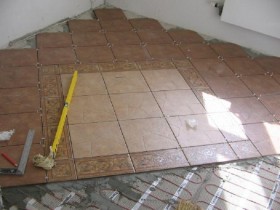
The disadvantages of this type include a large amount of waste. Each tile is subjected to extreme trim angle 450, to provide the ideal accommodation subsequent. This should be considered at the stage of its purchases.
To achieve the ideal overall pattern geometry parameters necessary, to each individual fragment of the fabric has regular geometrical dimensions. Otherwise, even a deviation in 1-2 mm lead to a distortion of the picture.
Diagonal stacking type can be applied for the floor, and wall. Mounting of the first series will be equally complex, so this work should be trusted only to experienced professionals.
herringbone
Method for laying herringbone tile is not so common because of the special complexity of its implementation. The main condition for the successful finish is ideal geometric similarity tiles and moreover it has to be rectangular shape. Its length should be a multiple of the width. Laying process is similar to the mounting floorboard on the floor. The work is very difficult and requires excellent craftsmanship. Moreover, in the process of laying waste mass will be formed. General tiling angle to the walls of the room 450. Here it is important to strictly follow to complete installation, otherwise there will be distortion of the geometry and the damage of the picture. Such a method has most widely used previously, but today it is less popular.
Modular type of presentation
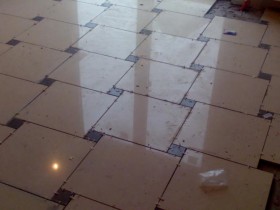
Modular tile type is the most complex type, because it is the assembly of individual fragments, consisting of several elements fitted perfectly. Component composition is a single finished drawing, which may be located in conjunction with other components, and individually. Select tile to the modular masonry should be from the same series, and from the same manufacturer. Today, commercially available tile, specially designed for the modular layout. It has the appropriate markings - module. Modular method can be used for both horizontal layouts, and the diagonal. Usually, alternating high-contrast colors - black and white, beige and dark brown.
Today, it is often possible to meet the modular version of tile in the kitchen over the work areas or in the bathroom. At all, it is an original way, with which you can enhance the mood of the internal space of the room.
Photopanel, or a new word in the design
Today increasingly used tiles with a full photo print on it. There is not a single company, which is engaged in printing on ceramics and coating it with a protective layer of Glazed. If necessary, they can order prints of absolutely any image. The direction of the tile location may be different.

tiling technology
Before embarking on a tiling should be carefully prepared base. old tiles, plaster and the remains of the solution and must be removed to clean the surface from dust. When insecurity rough bases must be removed and the old tie.
It must be remembered, that the least amount of problems when laying the tiles will be exactly on a level surface. Therefore, it is necessary align.
This can be done leveling screeds or leveling mixture. In the first case tiling previously leveled surface to be treated Primers, deep penetration. When using this leveling compositions can not perform. To align the walls can be applied pre-plaster or vlagostoykiy drywall.
After complete drying of crude base you can start laying the tiles. But before that, you must first apply the layout and install beacons. Installation starts from a flat wall and extends to the opposite. View details video on laying the tiles on the wall. See more tips and video on laying the tiles on the floor.
For high quality bonding with the surface of the tile adhesive layer should be of uniform thickness over the whole area. It should be applied with a notched trowel, uniformly distributing on the surface pasted.
Further, Tile is laid in relation to marking lines, and carefully aligned. The seam between two adjacent tiles to be installed calibration crosses. They provide the same distance and excellent appearance of the whole picture as a whole.
To align the horizontal surface when laying tiles can apply special wedge clamps. They firmly tighten the two adjacent tiles to a single plane. After complete solidification of the adhesive, these clips can be easily removed.
All seams after the tile must be carefully cleaned with a spatula, and after curing the adhesive to cover fugue tone in the fabric. It will provide not only a pleasing appearance, but also excellent protection against moisture, but, Consequently, and from the formation of mold. Quickly read the right amount of material to help our online calculators. find out! as you need tiles on the floor, tile adhesive, grouting.












